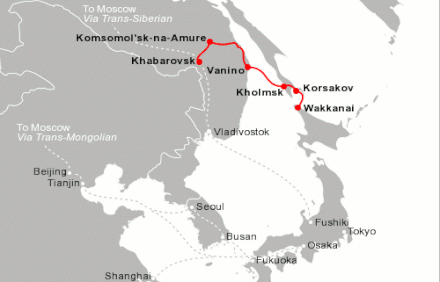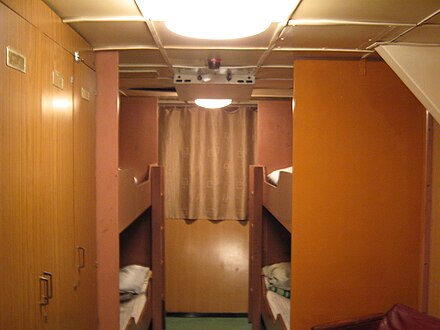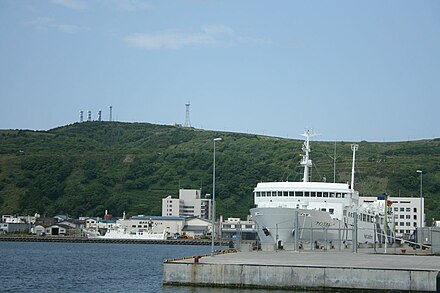Russia to Japan via Sakhalin
Russia to Japan via Sakhalin
Since 2019, it has been impossible to complete this itinerary due to a lack of ferry service between Sakhalin and Hokkaido.
Russia to Japan via Sakhalin covers the journey from the Russian Far East through Sakhalin Island to Japan.
Understand
This itinerary describes one of two possible options for continuing a Trans-Siberian Railway journey to Japan, via the island of Sakhalin in Russia's far east. The other possible routes are by ferry from Tianjin (the terminus of the Trans-Mongolian Railway near Beijing) to Kobe, near Japan's 2nd city, Osaka. This itinerary is interesting as it ends in Wakkanai, Japan's northernmost city, and therefore allows travelers the opportunity of continuing through Japan from north to south in a straight line and to get well off the beaten path in both countries.
There were ferry routes directly departing from Vladivostok (the terminus of the Trans-Siberian Railway) to Takaoka on the central coast of Honshu, Japan's main island and from Vladivostok via South Korea's Donghae to Sakaiminato in the western part of Honshu, but both routes were discontinued by the late 2010s.
Prepare
Please refer to the Trans-Siberian Railway article for general information about this great railway journey.
Bring a phrasebook. As this journey takes you far off the beaten path, don't expect anyone to speak English. Bringing a Russian phrasebook is not only recommended to help the traveler socialize with fellow cabin mates during the trip, and thus enriching the experience of this trip immensely - but also perhaps more importantly, it's invaluable help should you encounter any emergencies. Once you have finished the journey, you may also find a Japanese phrasebook useful as you venture out from the port.
Have your papers in order. Sakhalin is designated a special border region, and as such, the movement of foreigners is limited. Because of this, travelers should pay special attention to the Russian registration rules if he or she plans on entering Sakhalin, and have all the paperwork (registration stamps and train tickets) ready on disembarkation in Kholmsk. It is also advisable to have the name, address and telephone number for the intended accommodation on Sakhalin Island written in Russian, for the Sakhalin customs officials.
Certain nationalities require a visa to enter Japan, while citizens from most Western nations can obtain landing permission on arrival. There are Japanese consulates in Yuzhno-Sakhalinsk and Khabarovsk. You are required to provide information on your first night's accommodation on the disembarkation card, and to purchase ferry tickets for the Korsakov-Wakkanai ferry.
Pack warm clothes. Even in summer, Sakhalin can be quite chilly, so be sure to bring a jacket and long pants.
Get in

There are two options for reaching Sakhalin over land, the easiest of which is branching off the main Trans-Siberian line in Khabarovsk, the last major station before the terminus in Vladivostok. More adventurous travelers can travel by the more exotic but poorly served Baikal-Amur Mainline to Komsomolsk and enter the route from there. It is of course also possible to reach Sakhalin and Khabarovsk by air, although some would argue that it kind of defeats the purpose of the journey.
See
There really isn't any particular point of interest along the route - that is not to say that there is nothing to see, and the Wikivoyage guides for the cities along the route are full of listings for attractions you can check out while there. However, since heading off to Sakhalin in the first place takes a fair bit of planning and effort, you really owe it to yourself to at least seriously consider spending the extra time, effort and above all money it takes to venture off the direct path from A to B, and out into the islands spectacular outdoors. Furthermore Komsomolsk-on-Amur, has equally spectacular landscape right at it's doorsteps, and is a good place to organize excursions into the renowned nature reserves of Khabarovsk Krai.
You will however, have to be more than your average seasoned traveler, and have some command of the Russian language to get anything organized on your own accord, and most will have to enlist the aid of local or a tour agent to see more than the sneak peeks you can catch from the window of your preferred mode of transport. Below are some suggestions for destinations that relatively easy can be reached from stops along the route;
- Sikachi-Alyan —
- Komsomolsky Nature Reserve —
- Moneron —
- Lake Tunaycha —
- Rishiri-Rebun-Sarobetsu National Park —
Go
1st leg: Khabarovsk to Komsomolsk
There are several options to consider on this leg of the journey. The easiest, no doubt, is by train, but a more interesting way, is to take the daily hydrofoil services connecting the two cities, up the Amur river.
| | | | width="60pt" |Number | width="70pt" |Departure | width="60pt" |local | width="60pt" |Arrival | width="60pt" |local | | |008/667 | 14:10 | 21:10 | 00:10 | 07:10 | | |351/943 | 01:26 | 08:26 | 11:47 | 18:47 |
If you do not want to attract the wrong kind of attention, be considerate when you board the train, as the passengers who boarded in Vladivostok will mostly be asleep. The train ride is quite scenic, with occasional views over the Amur river. There are no longer stops on this leg where you could stock up supplies from the usual station sellers, but the train does have a decent restaurant car with a small shop, in case you forget to bring food and drinks. In Komsomolsk there is a 1-hour layover. The station has many shops selling fresh foods and other supplies.
| | | | width="60pt" |Number | width="70pt" |Departure | width="60pt" |local | width="60pt" |Arrival | width="60pt" |local | | |Meteor | - | 07:00 | - | 13:00 | |
This hydrofoil service departs from the Rechnoy Vokzal (river terminal), located a short but steep walk southwest of the city's massive cathedral. Stay in a hotel near the river due to the early departure times. It takes approximately 6 hours to cover the 300 km between the two cities. In Komsomolsk the ferry arrives at the river station, about 2 km south of the railway station, but they are connected by tram line number 2.
The train connection to Vanino does not depart Komsomolsk until 12:47 (19:47 local time), so you have a few hours to explore the city. Luggage can be stored at the station.
| | | | style="background:#cccc99;" width="330px" align="center" | Bus |
If Russia has left a hole in your wallet, the daily overnight bus between Khabarovsk and Komsomolsk is an option. As the train continuing to Vanino runs overnight, you can save 2 nights worth of accommodation, sacrificing some comfort. Road conditions are reported to be quite good by Russian standards.
<BR>2nd leg: Komsomolsk to Vanino
| | | | width="60pt" |Number | width="70pt" |Departure | width="60pt" |local | width="60pt" |Arrival | width="60pt" |local | | |351/352 | 12:47 | 19:47 | 02:50 | 09:50 | | | |953/954 | 09:56 | 16:56 | 00:52 | 07:52 | |
Well fed, and safe on the train, there is some good scenery to be seen as the train follows a river flowing through a valley, before it starts climbing a small mountain range, and darkness sets in. Next morning you will wake up with a view over the Pacific Ocean, and a attractive coastline. If you have come from St Petersburg, you have a little time to reflect on the achievement of traversing the Eurasian continent coast to coast, before arriving in the port city of Vanino. Upon arrival, it is a good idea to have your luggage ready, so you can be first in line to exit the train.
The train #953/954 starts in Komsomolsk and arrives very early to Vanino, giving you better chances to get a ticket to a cabin in the boat (but also more waiting time.) It's a seasonal service, running from the beginning of June to mid-September.
3rd leg: Vanino to Kholmsk
 After arriving in Vanino, tickets for the overnight ferry are sold in a small ticket window inside the station building. Enter the station from the train platform, and it will be at the opposite end of the main hall from where you entered.
After arriving in Vanino, tickets for the overnight ferry are sold in a small ticket window inside the station building. Enter the station from the train platform, and it will be at the opposite end of the main hall from where you entered.
Buying ferry tickets in Vanino is an altogether unpleasant experience, that even the local population consider a test of endurance. Below are some tips on securing some hard-fought tickets.
- Arrive the day before in Vanino and buy the tickets in quietness as the queue ends.
- Prebook tickets through a travel agency. While the service alone is as expensive as the tickets themselves, this enables you to forget everything learned about politeness, shove your way through the queue, and get your tickets straight away. Dalgeo tours in Khabarovsk has English speaking staff available, and will provide this service for (see Khabarovsk entry for contact details). Nata tours in Komsomolsk also does the job and even provides a person in Vanino to buy the ticket for you. (February 2010 quote from them for 1 berth in 2 berth cabin US$160, or US$250 in a single luxe cabin.) Be aware of the real ferry tickets before you commit and make sure which cabin type you got as soon as you receive the tickets.
- Have your luggage ready, queue up at the train doors before arrival, and run inside the train station to grab a top spot in the queue – although you will still have to wait 1½ hours till the ticket window opens.
- Remember there are few rules for queuing in Russia. Sneaking in front of other people at every given opportunity seems to be the norm.
- Try your luck: in July 2009 there was almost no queue on the arrival of the 05:30 train and the ticket booth was already open.
When you have secured a ticket, you can wait in the adjacent waiting room, until the bus leaves to the ferry. Schedules are random, so watch for the line in front of the ticket gate to empty, and then make your way to the parking lot at the northern end of the train platform. The standard is to squeeze in twice the number of people as the bus was designed for. The bus does a couple of shuttle rides to the port, so if you have a cabin place, no need to rush in the first bus.
The ferries are in a somewhat sorry state, with huge patches of rust everywhere on the ship, but all safety equipment you expect from a western ferry seems to be present. Facilities are limited, but there is a cafe on the main deck, with an assortment of Russian foods and alcoholic beverages - you'll be given a voucher for a meal was given at the entrance of the boat.
There are (supposedly, but maybe not on all ferries) 8-berth (), 4-berth () and 2-berth () cabins available, as well as "lyux" (deluxe) cabins at - these are the only cabins with a private shower/toilet and seats! The price for the cabins change almost nothing between the number of people they hold (around more for half the people!) The seats mean in general 'sleep somewhere over your luggage' - take the 2-berth cabin if they are still available. Note that that you will pay the price indicated at the board plus an extra for the bus.
4th leg: Kholmsk to Korsakov
 The ferry arrives in the dull port of Kholmsk on Sakhalin's eastern coast early in the morning. As you leave your cabin, make sure you have your ferry ticket, as it is required to get off the ship. During disembarkation you are required to show your ferry tickets, as well as your passport to local officials. So make sure both are within easy reach, as the cramped space makes disembarkation a rather crowded experience.
The ferry arrives in the dull port of Kholmsk on Sakhalin's eastern coast early in the morning. As you leave your cabin, make sure you have your ferry ticket, as it is required to get off the ship. During disembarkation you are required to show your ferry tickets, as well as your passport to local officials. So make sure both are within easy reach, as the cramped space makes disembarkation a rather crowded experience.
As of 2008, Sakhalin is designated a special border region, so the law now requires that you register with local authorities. At disembarkation the customs officer will keep your passport until all passengers have left the vessel. You will then be led inside the ferry terminal, where the officer will check your papers and subject you to a brief interview. No English spoken, so having the following information written in Russian will shorten your waiting time considerably:
- Date and place of exit (Sakhalin)
- Purpose of your visit
- Name, address and telephone number of your intended accommodation on the island.
Expect the above procedures to take at least one hour, though a wikivoyager has reported waiting 4 hours to get his back, while another didn't wait at all. In any case, once finished, head outside the main gate of the ferry terminal for connections to Yuzhno-Sakhalinsk, where you can either break up your journey, or continue to Korsakov.
| | | | style="background:#cccc99;" width="330px" align="center" | Bus |
There are both hourly buses () and minibus connections to Yuzhno-Sakhalinsk. The easiest option is to find a minibus, as they are more comfortable and have frequent departures (leave-when-full). Expect to pay between for a minibus. You might be forced to pay for an additional seat if you have a large backpack or similar.
In Yuzhno-Sakhalinsk the parking lot between the train station and post office doubles as a bus terminal. There are a several scheduled departures () for Korsakov, the first in the morning being at 07:20 (taking around 1 hour), which gives time to make the passport control (closing at 09:20) and catch the ferry at 10:00.
| | | | align="center" | Kholmsk - Yuzhno Sakhalinsk | | | | | | width="60pt" |Number | width="70pt" |Departure | width="60pt" |local | width="60pt" |Arrival | width="60pt" |local | | |903/904 | 14:35 | 21:35 | 23:29 | 06:29 | | | align="center" | Yuzhno Sakhalinsk - Korsakov | | | | | | |121/123 | 02:35 | 09:35 | 03:22 | 10:22 | |
If you are a train buff, and have endured the hardships of riding the Baikal-Amur Mainline across the Siberian plains, you might find it worthy of trying to take the Japanese built narrow-gauge railway to Yuzhno-Sakhalinsk – but since the direct line is now derelict, you'll need to catch a once or twice daily connection to Tomari (#1611) 80 km to the north, and take another once daily train (#123) from there to Yuzhno-Sakhalinsk or Korsakov. This huge detour is probably not worth the effort unless you are really dedicated. The morning train from Yuzhno-Sakhalinsk to Korsakov also arrives too late to catch the ferry on the same day.
5th leg: Korsakov to Wakkanai
According to information provided by Wakkanai City Government, the Korsako-Wakkanai ferry route has been indefinitely suspended since 2019.
Stay safe
Carry medical supplies. Outside Yuzhno-Sakhalinsk medical facilities are limited, and English speaking doctors nonexistent. Bringing a rudimentary first aid kit, and basic medicines for self treatment is recommended.
Be alert. Yuzhno-Sakhalinsk has the highest instance of youth crime in the entire Russian Federation. While there is no need to be overly paranoid about this, do travel sensibly and stay alert around young Russian men.
Go next
As you are in the northernmost city in Japan, the whole country awaits in front of you! However since you're in Wakkanai, don't cheat yourself for a visit to the Rishiri-Rebun-Sarobetsu National Park: ferries depart from the ferry terminal in front of you, a night in the Momoiwa-so Youth Hostel on Rebun island is highly recommended!
Going south, the railway from Wakkanai terminates in Asahikawa, Hokkaido's second largest city. (3 Limited express trains a day go all the way to Saporro there is 1 departing at 16:51 which arrives at 21:50 in Saporro (see also www.hyperdia.com for Japanese railway timetables.) From Asahikawa you can easily explore Japan's largest national park Daisetsuzan or continue onwards to Sapporo and the rest of Japan.
